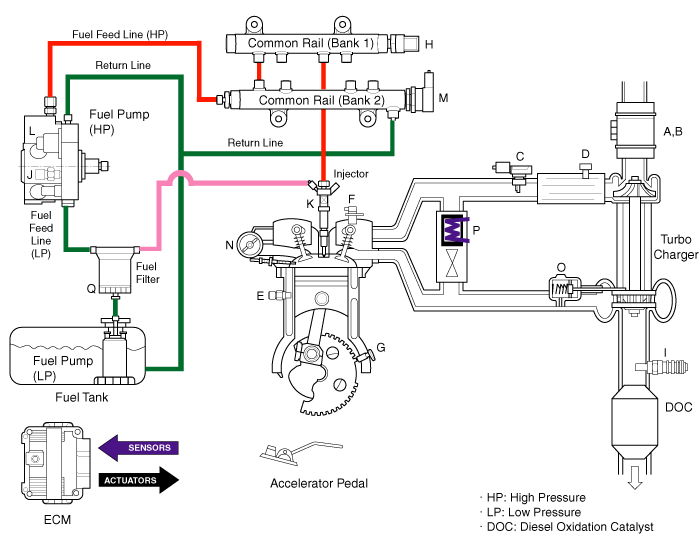

A. Mass Air Flow Sensor (MAFS) B. Intake Air Temperature Sensor (IATS) #1 C. Boost Pressure Sensor (BPS) D. Intake Air Temperature Sensor (IATS) #2 E. Engine Coolant Temperature Sensor (ECTS) F. Camshaft Position Sensor (CMPS) G. Crankshaft Position Sensor (CKPS) H. Rail Pressure Sensor (RPS) | I. Lambda Sensor J. Fuel Temperature Sensor (FTS) K. Injector L. Fuel Pressure Regulator Valve M. Rail Pressure Regulator Valve N. Variable Swirl Control Actuator O. Electric VGT Control Actuator P. Electric EGR Control Valve Q. Water Sensor |
The low pressure fuel pump is either an electric fuel pump with pre-filter, or a gear-type fuel pump. The pump draws the fuel from the fuel tank and continually delivers the required quantity of fuel in the direction of the high pressure fuel pump (via fuel filter).
The sub fuel sender is installed on the fuel tank which has separated fuel storeroom (LH & RH) and detects the fuel quantity of RH's one.
The fuel stored in RH is flown into the LH by the assist pump involved in the fuel pump in LH (The sub fuel sender doesn't have an independent pump).
The fuel filter is located in between the low pressure fuel pump and the high pressure fuel pump and filters the fuel delivered from the fuel tank.
The high pressure fuel pump compresses fuel up to 1,600 bar and delivers the compressed fuel to the common rail.
The two common rails are installed on bank 1 and 2 and are connected with the high pressure fuel pump and the injectors by the high pressure fuel pipes. This rail stores the fuel compressed in the high pressure fuel pump. So that the two rails have same fuel pressure, the high pressure fuel pipe connects the two rails.The ECM controls the fuel pressure of the common rail by using the rail pressure sensor and the rail pressure regulator valve installed on the common rail (Bank 1) and (Bank 2) respectively.
The injector injects the high pressure fuel stored in the common rail into the cylinder by the ECM control signal.
The high pressure fuel pipe is a channel in high pressure fuel circuit consisting of the high pressure fuel pump, common rails, and injectors. It is a steel tube which can withstand high frequency generated when the fuel pressure reaches the maximum pressure or fuel injection stops.
The differences in length between the common rail and the individual injectors are compensated for by using slight or pronounced bends in the individual lengths of tubing. Nevertheless, the injection lines should be kept as short as possible.